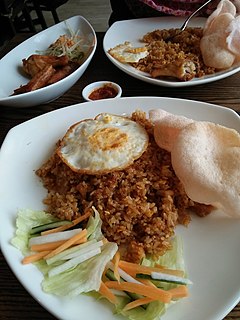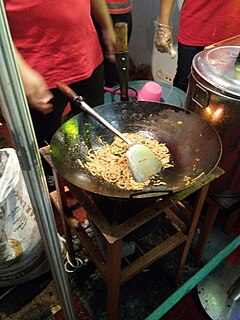Mie tarempa is a noodle dish that is popular in the Riau Islands. The food was discovered in the Anambas Island Regency. [1] Mie Tarempa is unique for its reddish looks, optional choice of meat, and wide and chewy noodles. The taste of the dish can be described as a mixture of sweet, sour, and spicy. [2] The dish is also considered to taste light despite the amount of oil that is found in the dish. The dish is considered to be affordable by the locals. The word “Mie'' derives from the Indonesian language, meaning noodles. The name “Tarempa” is known as a small town that is located in the Anambas Regency. [3]
The dish is simple to cook and requires simple ingredients. Although there are many variations of Tarempa noodles, authentic Tarempa noodles are the most popular. These are the ingredients that are often found in authentic Tarempa noodle recipes: [4]
Ground spices:
Complementary Ingredients (Optional according to taste):
Tarempa noodles are usually served in 2 different ways: dry and wet (with gravy). Authentic Tarempa noodles are usually dry. The addition of gravy is only used for more taste and texture. The taste between dry and wet Tarempa noodles does not differ much. It depends on the taste of each visitor who wants to enjoy the said dish. Besides that, there are also now a wide variation of toppings for the noodles. [5] At first, Tarempa noodles only used pieces of tuna. But now many Tarempa Noodle makers also add seafood and beef toppings. [6]

Indonesian cuisine is a collection of various regional culinary traditions that formed the archipelagic nation of Indonesia. There are a wide variety of recipes and cuisines in part because Indonesia is composed of approximately 6,000 populated islands of the total 17,508 in the world's largest archipelago, with more than 1,300 ethnic groups. Many regional cuisines exist, often based upon indigenous culture with some foreign influences. Indonesia has around 5,350 traditional recipes, with 30 of them considered the most important. Indonesia's cuisine may include rice, noodle and soup dishes in modest local eateries to street-side snacks and top-dollar plates.

Tempoyak, asam durian or pekasam is a Malay condiment made from fermented durian. It is usually consumed by the ethnic Malays in Maritime Southeast Asia, notably in Indonesia and Malaysia. Tempoyak is made by taking the flesh of durian and mixing it with some salt and kept in room temperature for three or five days for fermentation. Tempoyaks are usually made during the durian season, when the abundance of durian and excess production are made into fermented tempoyak.

Motabbaq is a stuffed pancake or pan-fried bread which is commonly found in the Arabian Peninsula and Southeast Asia, notably in Saudi Arabia, Yemen, Indonesia, Malaysia, Singapore, Brunei, Thailand and Bangladesh. Depending on the location, the name and ingredients can significantly vary. The name mutabbaq in Arabic means "folded". It is a popular street food in Yemen, Indonesia, Malaysia, Thailand and Singapore.

Chinese Indonesian cuisine is characterized by the mixture of Chinese with local Indonesian style. Chinese Indonesians, mostly descendant of Han ethnic Hokkien and Hakka speakers, brought their legacy of Chinese cuisine, and modified some of the dishes with the addition of Indonesian ingredients, such as kecap manis, palm sugar, peanut sauce, chili, santan and local spices to form a hybrid Chinese-Indonesian cuisine. Some of the dishes and cakes share the same style as in Malaysia and Singapore which are known as the Nonya cuisine by the Peranakan.

Nasi goreng is a Southeast Asian fried rice dish, usually cooked with pieces of meat and vegetables. One of Indonesia's national dishes, it is also endemic in Malay-speaking communities in countries such as Malaysia, Singapore and Brunei, and has gained popularity in Sri Lanka through migrations from the Malay Archipelago, in countries like Suriname via Indonesian immigrant communities, and in the Netherlands through its colonial ties with Indonesia. Nasi goreng is distinguished from other Asian fried rice preparations by its distinct smoky aroma, and caramelised yet savoury undertones of flavour. There is no single defined recipe for nasi goreng, and its composition and preparation varies greatly from household to household.

Peranakan cuisine or Nyonya cuisine comes from the Peranakans, descendants of early Chinese migrants who settled in Penang, Malacca, Singapore and Indonesia, inter-marrying with local Malays. In Baba Malay, a female Peranakan is known as a nonya, and a male Peranakan is known as a baba. The cuisine combines Chinese, Malay, Javanese, South Indian, and other influences.

Mee rebus, also known as mie rebus/mi rebus in Indonesian spelling, is a Maritime Southeast Asian noodle soup dish. Literally translated as "boiled noodles", it is popular in Maritime Southeast Asian countries such as Indonesia, Malaysia, and Singapore. In Indonesia it is also known as mie kuah, which literally means "noodle soup".

Bakmi or bami is a type of wheat based noodles derived from Chinese cooking tradition. It was brought to Southeast Asia by Chinese immigrants from Southern Chinese provinces like Fujian. It is typically prepared seasoned in soy sauce and topped with pork products, which is often substituted for other protein sources in predominantly Muslim Indonesia. Chinese-style wheat noodles has become one of the most common noodle dishes, especially in Southeast Asian countries which have significant Chinese populations and known by various names.

Mie goreng, also known as bakmi goreng, is an Indonesian style of stir-fried noodle dish. It is made with thin yellow noodles stir fried in cooking oil with garlic, onion or shallots, fried prawn, chicken, beef, or sliced bakso (meatballs), chili, Chinese cabbage, cabbages, tomatoes, egg, and other vegetables. Ubiquitous in Indonesia, it is sold by food vendors from street-hawkers, warungs, to high-end restaurants.

Javanese cuisine is the cuisine of Javanese people, a major ethnic group in Indonesia, more precisely the province of Central Java, Yogyakarta and East Java.

Kwetiau goreng is an Indonesian style of stir fried flat rice noodle dish. It is made from noodles, locally known as kwetiau, which are stir fried in cooking oil with garlic, onion or shallots, beef, chicken, fried prawn, crab or sliced bakso (meatballs), chili, Chinese cabbage, cabbages, tomatoes, egg, and other vegetables with an ample amount of kecap manis. In Asia, kwetiau is available in two forms, dried and fresh. Its recipe is quite similar to another Chinese Indonesian favourite, mie goreng, with the exception of replacing yellow wheat noodles for flat rice noodles.

Mie ayam, mi ayam, or bakmi ayam is a common Indonesian dish of seasoned yellow wheat noodles topped with diced chicken meat. It is derived from culinary techniques employed in Chinese cuisine. In Indonesia, the dish is recognized as a popular Chinese Indonesian dish, served from simple travelling vendor carts frequenting residential areas, humble street-side warung to restaurants.

Gado-gado is an Indonesian salad of raw, slightly boiled, blanched or steamed vegetables and hard-boiled eggs, boiled potato, fried tofu and tempeh, and lontong, served with a peanut sauce dressing.

Mie jawa, also called as mi jawa or bakmi jawa in Indonesia, or mee Jawa in Malaysia is a traditional Javanese style noodle, commonly found in Indonesia and Malaysia. The dish is made of yellow noodle, chicken, vegetables, egg and spices. The recipe however, is slightly different between mie jawa in Indonesia and mee Jawa in Malaysia.

Seblak is a Sundanese savoury and spicy dish, originating from West Java, Indonesia. Made of wet krupuk cooked with protein sources in spicy sauce. Seblak is a specialty of Bandung city, West Java, Indonesia. Seblak is common at restaurants, warungs, and gerobak (cart) street vendors. It is one of the most popular street foods in Indonesia, especially in Bandung and Jakarta.

Palembangese cuisine is the cuisine of the Palembangese people of the city of Palembang in the South Sumatra province of Indonesia. It is the second most well-known cuisine from Sumatra after Padang.

Makassarese cuisine is the cuisine of Makassarese people of Makassar in the South Sulawesi province of Indonesia.

Indonesian noodles are a significant aspect of Indonesian cuisine which is itself very diverse. Indonesian cuisine recognizes many types of noodles, with each region of the country often developing its own distinct recipes.